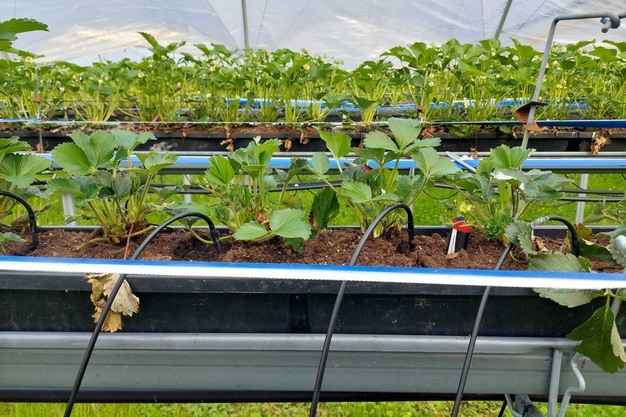"Italy's greenhouse growth is remarkable. The scale and pace at which protected cultivation has expanded, particularly around Bari, is a clear indicator of the country's strategic investment in controlled environment agriculture," Adam Formica, Chief Science Officer at Sensonomic, a Norway-based agri-tech company specializing in data-driven solutions for fresh fruit growers, states.
Italy has quietly become one of the global leaders in greenhouse agriculture, ranking third worldwide in total greenhouse area, behind only China and Spain. This shift reflects a broader transformation in the country's agricultural practices, with significant implications for food production, sustainability, and global trade.
 © Sensonomic
© Sensonomic
Above is a photo from a strawberry grower with whom Sensonomic is working with whose production is under plastic tunnels. Together with a company called ONiO, they are delivering distributed sensor systems (in red) to monitor growing conditions and forecast yields.
From bare fields to greenhouse clusters
Between 1985 and 2021, the area of greenhouses surrounding Bari expanded from virtually zero to more than 100 square kilometers. This explosive growth underscores a national trend of increasingly relying on covered production to stabilize yields, improve quality, and meet market demands.
"Bari is now home to the largest greenhouse cluster in Italy," he notes. "Other major clusters have also emerged in Taranto, Ragusa, Catania, Siracusa, Matera, Salerno, and Latina - regions that are becoming central nodes in Italy's fresh produce economy."
According to a 2024 study published in Nature Food by Tong et al., Italy accounts for 4.1% of the global greenhouse area. The study defines greenhouses broadly, including structures covered by polyethylene film, polycarbonate, and glass - materials that dominate Italy's protected cropping systems.
A mixed picture for tomatoes, strawberries, and lettuce
Greenhouse cultivation in Italy isn't limited to fruit. The country is also a major producer of covered vegetables. Between 2016 and 2024, the area under cover for tomatoes increased from 7,160 to 8,680 hectares. Lettuce followed a similar trend, growing from 4,550 to 5,530 hectares. However, strawberries saw a slight decline, from 2,970 to 2,730 hectares.
"These trends reflect both shifting market demands and the strategic choices made by growers," Adam mentions. "Controlled environments allow them to better manage resources and reduce the risks associated with climate volatility."
Top provinces vary by crop: Ragusa in Sicily leads in covered tomato production (3,520 ha), Caserta in Campania is the top for strawberries (510 ha), and Salerno (also in Campania) dominates lettuce production (1,800 ha).
Technology meets tradition
At Sensonomic, Adam and his team are helping bridge tradition and innovation. The company operates a digital platform that enables growers around the world, both in open-field and greenhouse settings, to capture and analyze data for improving harvest planning and fruit quality.
"We're based in Norway, but we work globally. By providing growers with the tools to anticipate harvest volumes and improve operational decisions, we're helping to make agriculture more predictable and profitable."
A model for the future?
Italy's greenhouse story offers valuable insights for countries looking to secure food production in the face of climate change and growing consumer demand. Adam highlights the convergence of advanced infrastructure, regional specialization, and data-driven tools in southern Italy.
"In many ways, Italy is becoming a model for modern Mediterranean agriculture. What's happening in Bari, Ragusa, or Salerno today may well represent the future of food production in climate-sensitive regions across the globe."
For more information:![]()
Sensonomic
Adam Formica, Chief Science Officer
adam.formica@sensonomic.com
linkedin.com/adamformica_italy
sensonomic.com
